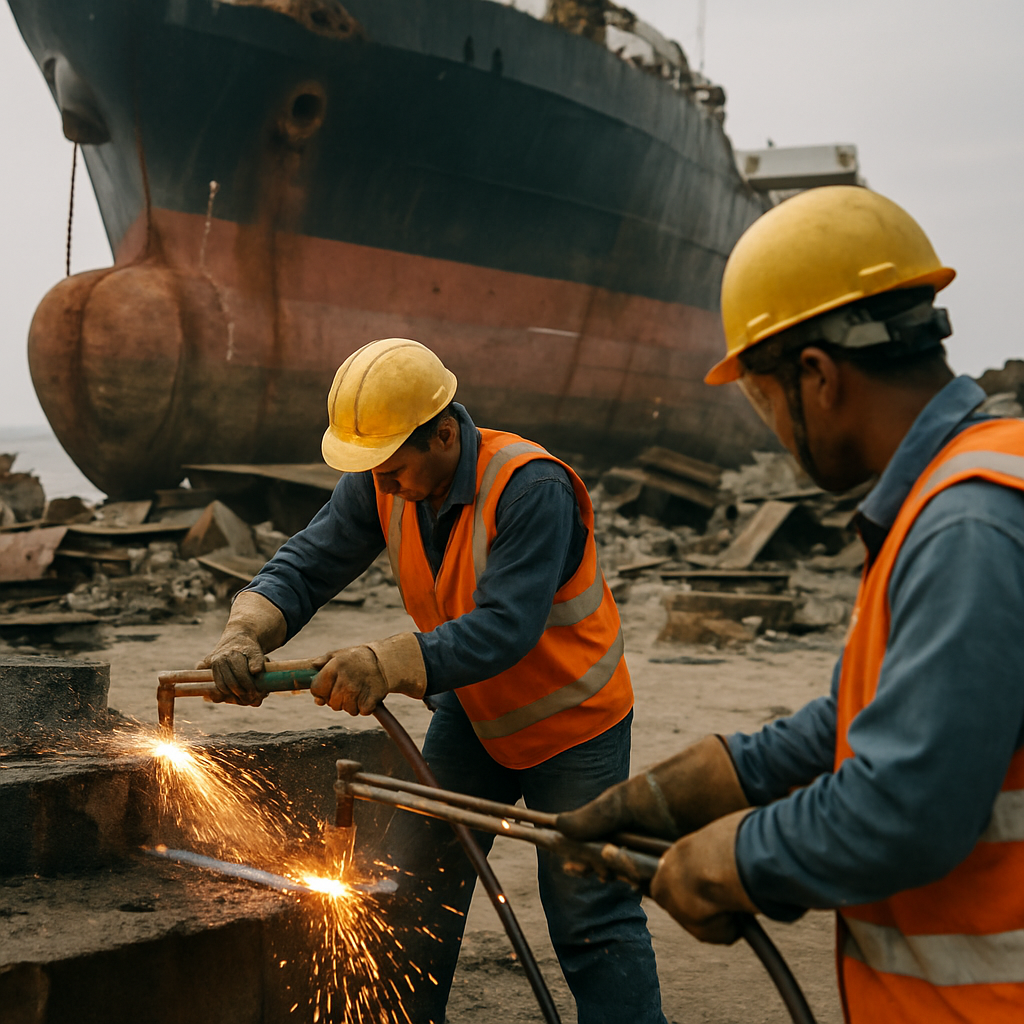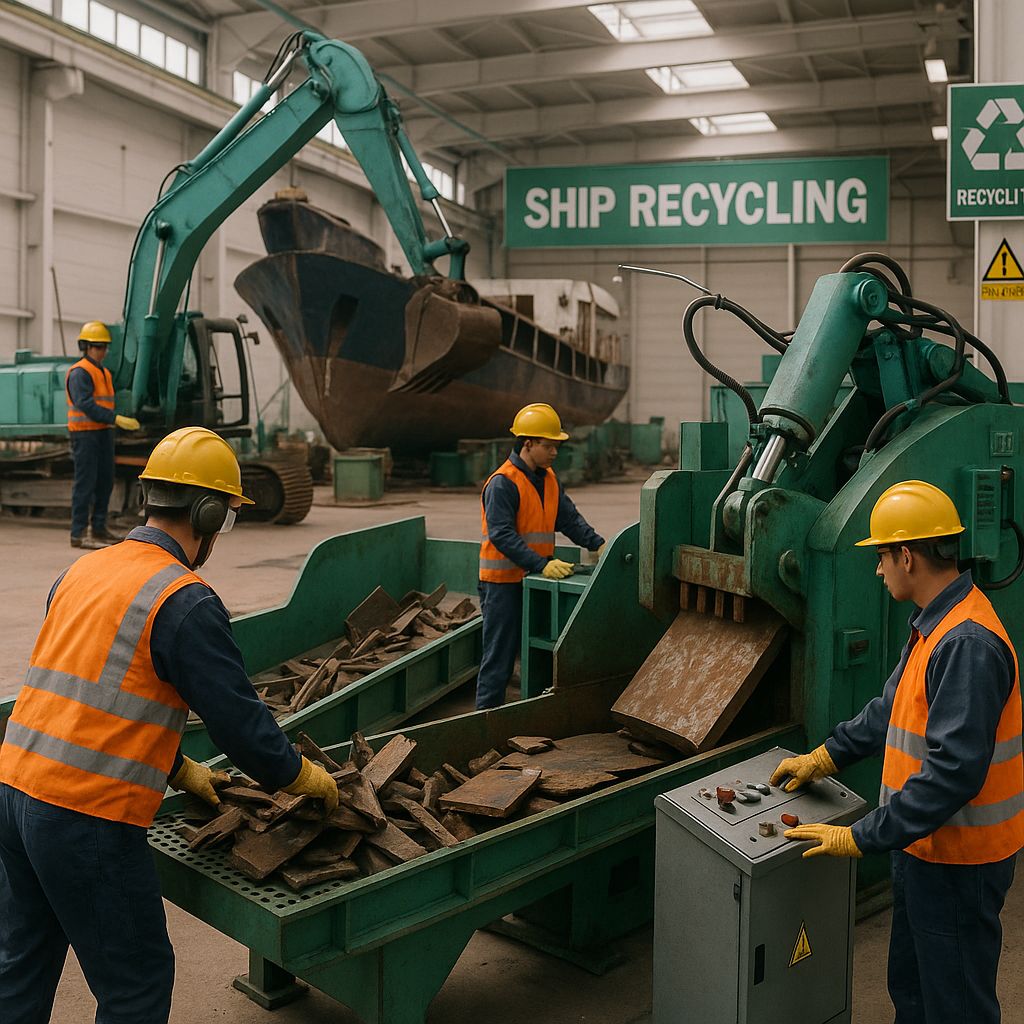5901 Botham Jean Blvd, Dallas, TX 75215
Understanding the Role of Ship Breaking and Metal Recycling in Maritime Sustainability
October 18, 2025Ship breaking and metal recycling represents one of the most crucial yet overlooked sectors of maritime sustainability. At its core, it’s the process of dismantling obsolete vessels that have reached the end of their 25-30 year operational lifespan to recover valuable materials. Ships become too expensive to maintain after decades of service due to corrosion, metal fatigue, and rising operational costs, making recycling the most practical solution.
The process begins with beaching—running ships ashore on gently sloping beaches at high tide. Once secured, workers systematically dismantle these maritime giants. First, they drain all fluids including fuel, hydraulic fluid, and lubricating oils. Then they remove valuable fixtures, machinery, and equipment that can be sold for reuse. Finally, they cut down the ship’s structure into manageable sections for recycling.
What makes this industry particularly valuable is its remarkable efficiency. Up to 90% of an old ship can be recycled or reused, with steel being the primary material recovered. This recycled steel requires significantly less energy to process than manufacturing new steel from iron ore, creating both environmental and economic benefits. In many countries like Bangladesh, recycled steel from ships provides up to 20% of the nation’s steel requirements—a testament to how this industry transforms maritime waste into valuable resources.
How is the Ship Breaking Process Conducted?

Ship breaking follows a systematic approach to safely dismantle vessels while maximizing material recovery. The process requires careful planning and execution to manage environmental impacts and worker safety.
Survey and Pre-Planning
Before any physical work begins, a thorough survey identifies all hazardous materials onboard. This critical first step creates an inventory of asbestos insulation, fuel residues, and other dangerous substances.
Teams develop a demolition plan that outlines the dismantling sequence. This plan establishes safety protocols for confined spaces and determines appropriate personal protective equipment for each phase of the operation.
Removing Hazardous Materials
The second phase focuses on safely removing and containing all hazardous materials. Workers extract fuel residues, insulating materials containing asbestos, and paints with toxic compounds.
This stage requires specialized equipment and rigorous safety measures. Workers often need respiratory protection when dealing with asbestos-wrapped pipes and other contaminated components.
Salvaging Valuable Equipment
Once hazardous materials are removed, salvage teams recover reusable and valuable items. This includes machinery, electronics, wiring, piping systems, and non-ferrous metals.
These components often have significant resale or recycling value. Careful extraction preserves their condition and maximizes their economic potential in secondary markets.
Scrapping the Vessel
The final phase involves cutting and dismantling the ship’s hull and structural components. Workers use gas torches to cut large steel sections into manageable pieces for transport and recycling.
This stage represents the most visible part of shipbreaking but can only begin after completing the previous safety-critical steps.
Different Methodologies
Shipbreaking practices vary significantly between regions. In developing countries like Bangladesh and India, ships are often beached during high tide and dismantled manually when waters recede.
Developed nations typically employ dry dock methods with advanced equipment and stricter environmental controls. These facilities contain potential pollutants more effectively but operate at higher costs.
The beaching method remains controversial due to environmental concerns. When ships are dismantled directly on beaches, containment of pollutants becomes difficult. Oil, heavy metals, and other contaminants can leach directly into coastal waters.
Regardless of method, proper shipbreaking requires balancing economic considerations with environmental protection and worker safety. Modern facilities increasingly focus on sustainable practices that maximize material recovery while minimizing ecological impact.
What Are the Environmental and Safety Concerns?
Ship breaking operations expose workers and surrounding environments to numerous hazardous materials. These include asbestos from insulation, heavy metals like lead and mercury, PCBs from electrical equipment, and oil residues that contaminate soil and water. The scale of these toxins is substantial, with a single vessel potentially containing tons of dangerous substances that require specialized handling.
The environmental impact extends well beyond the immediate work area. When hazardous materials leach into coastal waters, they destroy marine ecosystems and contaminate local food supplies. Soil pollution can persist for decades, rendering surrounding land unusable for agriculture or safe habitation. Air quality suffers as well, with particulate matter from cutting operations and toxic fumes affecting communities near breaking yards.
Worker safety presents equally alarming concerns in the industry. Ship breakers often work without basic protective equipment like helmets, gloves, or respiratory protection. Many facilities lack proper training programs on handling dangerous materials or operating heavy equipment. Falls, explosions, exposure to toxic substances, and crushing injuries are common in an industry where safety protocols are frequently overlooked.
The problem is particularly severe in developing nations where regulatory oversight remains minimal. Countries like Bangladesh, India, and Pakistan host major ship breaking operations with limited environmental and occupational safety enforcement. Workers often lack access to medical care after injuries or exposure to harmful substances. Local communities bear the environmental burden through contaminated water supplies and polluted coastlines.
International efforts to address these issues have emerged through various regulatory frameworks. The Basel Convention regulates transboundary movements of hazardous wastes, while the Hong Kong International Convention specifically targets safe ship recycling practices. These regulations aim to implement proper waste management systems, worker safety protocols, and environmental protection measures throughout the recycling process.
Despite these international standards, implementation and enforcement vary widely across different regions. The economic pressures to process ships cheaply often conflict with the investment needed for proper safety and environmental measures. Progress requires stronger global cooperation, increased transparency in ship recycling supply chains, and technical support for yards in developing nations.
| Hazardous Material | Environmental Impact | Safety Impact on Workers |
| Asbestos | Causes long-term environmental pollution when released into the soil and coastal waters. | Exposure can lead to respiratory diseases, including cancer. |
| PCBs (Polychlorinated Biphenyls) | Contaminates soil and water, affecting marine and terrestrial ecosystems. | Can cause skin and liver damage, as well as being a probable human carcinogen. |
| Heavy Metals (Lead, Mercury) | Pollute local waterways and contribute to the degradation of marine life. | Exposure can result in neurological and developmental damage, particularly in children. |
| Oil Residues | Contaminate water bodies, affecting aquatic life and local drinking water sources. | Pose explosion risks and can cause skin and respiratory issues when not handled properly. |
Some facilities have begun adopting improved methods for hazardous waste containment and worker protection. These include impermeable floors to prevent soil contamination, proper storage facilities for hazardous materials, and comprehensive training programs. Regular health monitoring for workers and environmental testing around facilities represent crucial steps toward responsible ship recycling practices.
How is Metal Recycled from Ships?
Metal recycling stands as the cornerstone of the ship breaking industry. Ships contain vast amounts of valuable metals that can be recovered and repurposed rather than mining new resources. Steel makes up approximately 95% of a ship’s body weight, with the remaining 5% consisting of non-ferrous metals like copper, aluminum, brass and other alloys.
The recycling process begins with careful sorting of metals after they’re removed from the vessel. Workers separate ferrous metals (containing iron) from non-ferrous metals using magnetic separation techniques. Steel, being magnetic, can be easily identified and separated from other materials. Copper wiring, aluminum components, and brass fixtures require more meticulous manual sorting.
Once sorted, the metals undergo shredding to reduce them into smaller, more manageable pieces. Large industrial shredders cut the steel plates into pieces suitable for transportation to melting facilities. This step improves melting efficiency and reduces the energy needed in subsequent processing.
The final stage involves melting the metals in electric arc furnaces. Steel scraps are transformed at temperatures exceeding 1600°C into new steel products. The melting process for aluminum requires significantly less heat—about 660°C—making it even more energy-efficient to recycle. Copper melts at approximately 1085°C and is processed separately from other metals due to its unique properties and higher value.
The environmental benefits of ship metal recycling are substantial. Recycling one ton of steel conserves approximately 2,500 pounds of iron ore, 1,400 pounds of coal, and 120 pounds of limestone. The energy savings are equally impressive. Producing steel from scrap requires about 60% less energy than making it from raw materials. For aluminum, the energy savings reach up to 95%.
In specialized facilities like those at Alang in India, almost all metal components from ships find new life. Steel is commonly repurposed into construction materials, while copper often becomes electrical components and aluminum transforms into various consumer goods. This circular approach to metal resources prevents millions of tons of waste from entering landfills annually while reducing the environmental impact of mining new materials.
What is the Future of Ship Breaking and Metal Recycling?

The ship breaking and metal recycling industry stands at a critical turning point. Environmental safety standards are improving alongside technological innovations that make sustainable recycling increasingly viable. The Hong Kong International Convention, set to come into force in June 2025, represents a significant milestone for the industry. This agreement establishes minimum global standards for safe, environmentally sound ship recycling practices that protect both workers and ecosystems.
Technological advancements are reshaping how vessels are dismantled and materials recovered. AI-driven automation, robotics, and advanced cutting techniques are reducing hazards while improving efficiency. Projects like SHEREC (Safe, Healthy, and Environmental Ship Recycling) demonstrate how drones equipped with multimodal sensors can inspect hazardous areas before human intervention. Meanwhile, automated cutting systems bring precision to dismantling processes, minimizing environmental impacts.
The industry faces challenges in balancing these improvements with economic realities. While beaching methods in South Asia remain cost-effective, they pose significant environmental and human health risks. Shifting operations to better-equipped facilities in developed countries may improve standards but raises questions about economic viability. The success of facilities like International Shipbreaking in Texas shows that environmentally responsible practices can be economically sustainable with proper investment and regulatory support.
For businesses needing responsible recycling solutions for metal waste, contact Okon Recycling at 214-717-4083.
